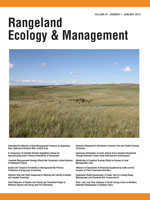Temperate grasslands are generally considered carbon (C) sinks, but climate and management likely affect whether they accumulate or lose C on an annual time step. The North Central Region of the United States contains highly productive improved pasture that is used exclusively for livestock grazing and mechanical harvest. The objective of this study was to use a net ecosystem carbon balance (NECB) approach to estimate C accumulation or loss in subhumid pastures under four typical livestock management practices: management-intensive rotational grazing (MIRG), continuous grazing (CONT), haymaking (HARV), and land set aside with no harvests (NONE). MIRG lost significantly less C in 2006 than all other treatments, and in 2007 MIRG was the only treatment that had a positive NECB. For 2006, our model resulted in an average change of −236 ± 15 (CONT), −100 ± 24 (MIRG), −391 ± 11 (HARV), and −276 ± 28 (NONE) g C · m−2 · y−1. For 2007, the change was −234 ± 56 (CONT), 106 ± 69 (MIRG), −200 ± 25 (HARV), and −171 ± 38 (NONE) g C · m−2 · y−1. Increased C fixed as net primary production (NPP) and C imported as hay and grain resulted in the MIRG treatment having the most favorable C balance. Even with imported hay and grain, reduced NPP in the CONT treatment led to a less favorable C balance. In the HARV treatment, high biomass removal drove the negative C balance, while the relationship between reduced NPP and heterotrophic respiration alone drove the negative C balance in the NONE treatment. Climate change mitigation services provided from ecosystem C accumulation relative to cultivation may be warranted for pastures, but when all cross-boundary transfers of C are not considered, significant misconceptions can occur regarding how different management strategies affect the NECB of subhumid pasture.
How to translate text using browser tools
1 January 2014
Livestock Management Strategy Affects Net Ecosystem Carbon Balance of Subhumid Pasture
Lawrence G. Oates,
Randall D. Jackson
ACCESS THE FULL ARTICLE
improved pasture
management-intensive rotational grazing
net ecosystem carbon balance
net primary production
soil respiration





